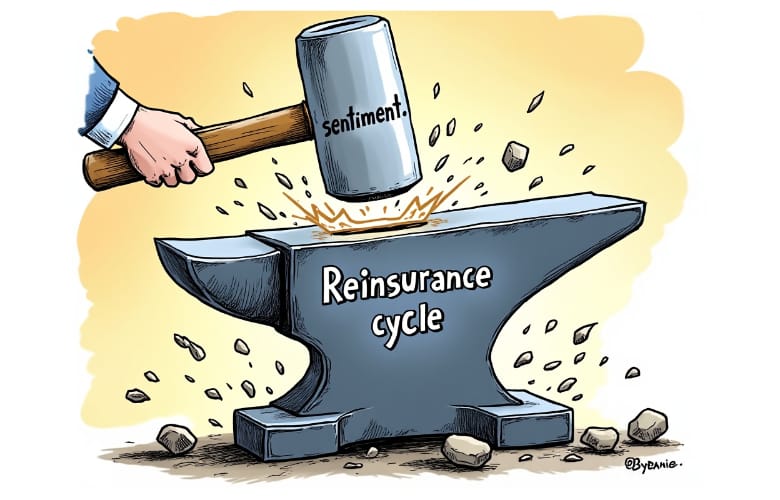Reinsurance mood shifts to capitalising on hard market pricing while it lasts: AM Best

The mood in reinsurance has shifted somewhat, with the Big Four European reinsurers now focusing on taking advantage of higher pricing while it lasts, rating agency AM Best believes.
In a new report focused on the four major European reinsurance giants, Hannover Re, Munich Re, SCOR and Swiss Re, AM Best explains that since the reinsurance reset on pricing and terms these large companies have been loading up on risk, especially property catastrophe.
While at the same time, there has been clear evidence of growth across specialty reinsurance books as well.
Hard reinsurance market conditions persist so far in 2024, with some slight softening in selective areas and programs at the mid-year, but an overall environment of stability.
While price has moderated and flattened, terms and conditions, as well as all-important attachment points, so far remain stable as well.
AM Best comments on the current conditions and the fact the reset has proven persistent up to now.
“With the hard reinsurance market conditions continuing in 2024, the Big Four European reinsurers have good appetites for property catastrophe.
“This follows a period of right-sizing of portfolios, increases in attachment points, and a move away from aggregate covers and working layers,” the rating agency said.
As a result of this, “Europe’s four largest reinsurers reported strong results in 2023 and the first half of 2024 for their non-life reinsurance segments, benefitting from continued strong pricing and terms.”
While profitability and growth both accelerated since the reset of reinsurance across 2022 into 2023 renewals, the question is always about the sustainability of these conditions and whether the appetite of these major reinsurers could begin to see them giving back some of the gains made.
AM Best believes that the mood has shifted, away from one of determination to sustain the current hard market, more to one of feeling the need to capitalise on it while it lasts.
The rating agency said, “Although there is no sign yet of this discipline disappearing, the mood has shifted somewhat to focus on taking advantage of the good pricing while it lasts.”
We’ve seen this before, of course.
Reinsurance rates, especially property catastrophe, hardened considerably after the impactful loss year of 2025, and while they did quickly moderate, the financial crisis in 2008 and loss activity around 2011 both helped to sustain the firmer environment.
But from 2012 through 2017, major global reinsurance firms sought to take advantage of pricing and also build market shares and this coming at the same time as the expansion of private insurance-linked securities (ILS) and collateralized reinsurance resulted in rates being chased down and terms and conditions being considerably widened.
Underpinning that was again a feeling of not wanting to miss out and that capitalising on price even as it softened was better than getting to the softest part of the cycle while there was a fear we might not see similar peaks again (remember that was around the time many were saying ILS would kill the market cycle entirely).
Which proved to be wrong anyway, but here we are again at a stage where reinsurance pricing and terms are at a high and looking stable, but major traditional players are now looking to make the most of this while it lasts.
All of which might bring you a feeling of deja vu. But it is a little early to say things won’t be different this time.
Those that experienced and were even instrumental in the softening from 2012 through 2017 have seen it before and have no desire to go back to the super-soft pricing and super-stretched terms of coverage we saw then.
At the same time, little has changed significantly in terms of the efficiency of the reinsurance market’s structure or operations and way it transacts.
The one ongoing change is the continuing maturation of the relationship with alternative capital and ILS in reinsurance, which could be a moderating effect going forwards, but we feel is more likely to be a growth stimulator than anything else to begin.
Meaning it is appetites and the fear of missing out that could be the main driver of the next softening of the cycle, if and when it occurs.
We’re also hearing of brokers pushing reinsurers to be more open to providing cover lower-down at the end of year renewals, while some are saying that access to the prime upper-layers of towers may be most freely available to those that consider also providing lower-down protection, aggregates and sideways covers.
Sentiment and fear are critical drivers of reinsurance cycles, both in terms of losses, perceived threats, but also of failing to capitalise on the current peak.
The one positive we’re seeing this time around that could mean the current peak is sustained for longer, is the fact many reinsurers are going for growth and expansion, rather than just scooping up some of the higher rate US property cat risks before they soften (which we saw all too clearly from 2012 through 2017).






